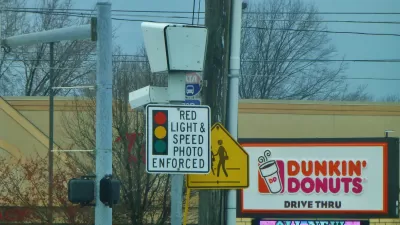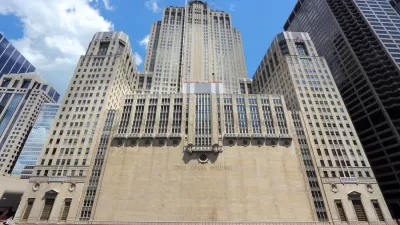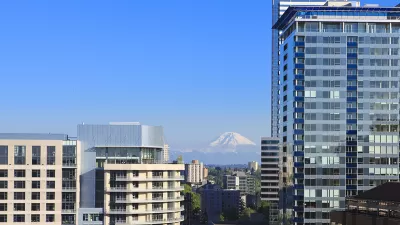Eric Jaffe of CityLab looks at what went wrong with what should have been a clear way to employ technology to reduce crashes and save lives, and what can be done to stem the tide of cities removing red light cameras.
"Generally speaking, red light cameras do an excellent job of reducing 'red-light related' crashes—the highly dangerous T-bone collisions that occur when a driver blows a red once other traffic has entered an intersection," writes Eric Jaffe. So why are they so detested that communities are removing and even banning them?
Jaffe references an incredibly wide array of national news articles, data analysis, and academic, technical, and federal reports from throughout the country. "Houston voters banned the life-saving technology in 2010, with the press mostly cheering (CBS Morning News, Nov. 2012) them along," writes Jaffe.
Last year Houston PD examined how that’s impacted safety at intersections. According to department data [Streetsblog chart (PDF)] their predictions have been borne out.
However, in many cases, meaning at specific intersections in cities throughout the country, e.g., Albuquerque, crashes went down when the cameras were removed. Specifically, "rear end" crashes decreased after the cameras were removed.
Recent academic studies in Charlotte and Los Angeles have found post-camera increases in rear-end collisions. The Chicago Tribune recently conducted its own study of the city’s camera program, and while it did find a 15 percent decline in right-angle crashes, it found a 22 percent rise in rear-end collisions, too.
A 2005 Safety Evaluation of Red-Light Cameras by the Federal Highway Administration supports that finding:
A literature review found that estimates of the safety effect of red-light-running programs vary considerably. The bulk of the results appear to support a conclusion that red light cameras reduce right-angle crashes and could increase rear end crashes.
"That might explain why red light camera programs are on the decline," writes Jaffe. "Down from a reported high of 540 communities with cameras in 2012, only 443 have them today, according to the Insurance Institute for Highway Safety.
There might be some middle ground to salvage yet. Extending yellow lights, which has been shown to decrease rear-end collisions, might help.
The other complaint Jaffe investigates is alleged corruption, be it messing with length of the yellow lights or unaccountable surges in automated citations. The role of the private contractors has become a central focus for the complaints as Yonah Freemark explained in CityLab in Oct. 2011. Even CALPIRG felt compelled to investigate the role of "privatized traffic law enforcement" (posted here).
But even with the increase in rear end collisions, the cameras show themselves to be a public health benefit. "(T)he lesser severities and generally lower unit costs for rear end injury crashes together ensure that the increase in rear end crash frequency does not negate the decrease in the right-angle crashes targeted by red-light-camera systems," states the FHWA evaluation.
FULL STORY: Why Red Light Cameras Have Big Safety Benefits But Little Support

Study: Maui’s Plan to Convert Vacation Rentals to Long-Term Housing Could Cause Nearly $1 Billion Economic Loss
The plan would reduce visitor accommodation by 25,% resulting in 1,900 jobs lost.

North Texas Transit Leaders Tout Benefits of TOD for Growing Region
At a summit focused on transit-oriented development, policymakers discussed how North Texas’ expanded light rail system can serve as a tool for economic growth.

Why Should We Subsidize Public Transportation?
Many public transit agencies face financial stress due to rising costs, declining fare revenue, and declining subsidies. Transit advocates must provide a strong business case for increasing public transit funding.

Alabama: Trump Terminates Settlements for Black Communities Harmed By Raw Sewage
Trump deemed the landmark civil rights agreement “illegal DEI and environmental justice policy.”

Dear Tesla Driver: “It’s not You, It’s Him.”
Amidst a booming bumper sticker industry, one writer offers solace to those asking, “Does this car make me look fascist?”

A Visual Celebration of Manhattan’s Chinatown Elder Community, Through Food
Lanterns, cafeteria trays, and community connection take center stage in this stunning photo essay.
Urban Design for Planners 1: Software Tools
This six-course series explores essential urban design concepts using open source software and equips planners with the tools they need to participate fully in the urban design process.
Planning for Universal Design
Learn the tools for implementing Universal Design in planning regulations.
City of Santa Clarita
Ascent Environmental
Institute for Housing and Urban Development Studies (IHS)
City of Grandview
Harvard GSD Executive Education
Toledo-Lucas County Plan Commissions
Salt Lake City
NYU Wagner Graduate School of Public Service





























